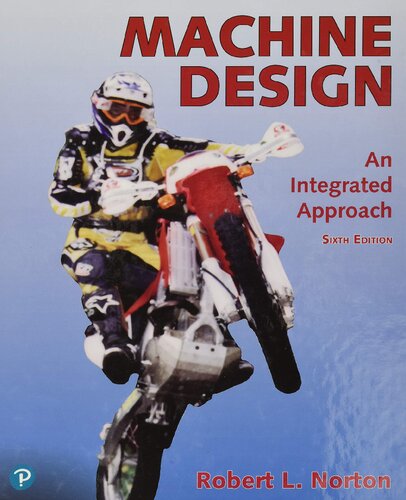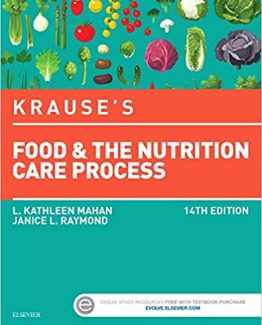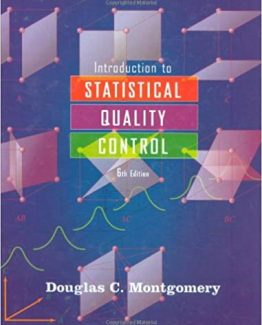Machine Design: An Integrated Approach 6th Edition by Robert Norton, ISBN-13: 978-0135184233
[PDF eBook eTextbook]
- Publisher: Pearson; 6th edition (August 31, 2019)
- Language: English
- 1120 pages
- ISBN-10: 0135184231
- ISBN-13: 978-0135184233
For courses in Machine Design.
An integrated, case-based approach to machine design.
Machine Design: An Integrated Approach, 6th Edition presents machine design in an up-to-date and thorough manner with an emphasis on design. Author Robert Norton draws on his 50-plus years of experience in mechanical engineering design, both in industry and as a consultant, as well as 40 of those years as a university instructor in mechanical engineering design.
Written at a level aimed at junior-senior mechanical engineering students, the textbook emphasizes failure theory and analysis as well as the synthesis and design aspects of machine elements. Independent of any particular computer program, the book points out the commonality of the analytical approaches needed to design a wide variety of elements and emphasizes the use of computer-aided engineering as an approach to the design and analysis of these classes of problems.
Table of Contents:
Brief Contents PART I: FUNDAMENTALS Introduction to Design 1.1 Design Machine Design 1.2 A Design Process 1.3 Problem Formulation and Calculation Definition Stage Preliminary Design Stage Detailed Design Stage Documentation Stage 1.4 The Engineering Model Estimation and First-Order Analysis The Engineering Sketch 1.5 Computer-Aided Design and Engineering Computer-Aided Design (CAD) Computer-Aided Engineering (CAE) Computational Accuracy 1.6 The Engineering Report 1.7 Factors of Safety and Design Codes Factor of Safety Choosing a Safety Factor Design and Safety Codes 1.8 Statistical Considerations 1.9 Units 1.10 Summary 1.11 References 1.12 Web References 1.13 Bibliography 1.14 Problems Materials and Processes 2.0 Introduction 2.1 Material-Property Definitions The Tensile Test Ductility and Brittleness The Compression Test The Bending Test The Torsion Test Fatigue Strength and Endurance Limit Impact Resistance Fracture Toughness Creep and Temperature Effects 2.2 The Statistical Nature of Material Properties 2.3 Homogeneity and Isotropy 2.4 Hardness Heat Treatment Surface (Case) Hardening Heat Treating Nonferrous Materials Mechanical Forming and Hardening 2.5 Coatings and Surface Treatments Galvanic Action Electroplating Electroless Plating Anodizing Plasma-Sprayed Coatings Chemical Coatings 2.6 General Properties of Metals Cast Iron Cast Steels Wrought Steels Steel Numbering Systems Aluminum Titanium Magnesium Copper Alloys 2.7 General Properties of Nonmetals Polymers Ceramics Composites 2.8 Selecting Materials 2.9 Summary 2.10 References 2.11 Web References 2.12 Bibliography 2.13 Problems Kinematics and Load Determination 3.0 Introduction 3.1 Degree of Freedom 3.2 Mechanisms 3.3 Calculating Degree of Freedom (Mobility) 3.4 Common 1-DOF Mechanisms Fourbar Linkage and the Grashof Condition Sixbar Linkage Cam and Follower 3.5 Analyzing Linkage Motion Types of Motion Complex Numbers as Vectors The Vector Loop Equation 3.6 Analyzing the Fourbar Linkage Solving for Position in the Fourbar Linkage Solving for Velocity in the Fourbar Linkage Angular Velocity Ratio and Mechanical Advantage Solving for Acceleration in the Fourbar Linkage 3.7 Analyzing the Fourbar Crank-Slider Solving for Position in the Fourbar Crank-Slider Solving for Velocity in the Fourbar Crank-Slider Solving for Acceleration in the Fourbar Crank-Slider Other Linkages 3.8 Cam Design and Analysis The Timing Diagram The svaj Diagram Polynomials for the Double-Dwell Case Polynomials for the Single-Dwell Case Pressure Angle Radius of Curvature 3.9 Loading Classes For Force Analysis 3.10 Free-body Diagrams 3.11 Load Analysis Three-Dimensional Analysis Two-Dimensional Analysis Static Load Analysis 3.12 Two-Dimensional, Static Loading Case Studies 3.13 Three-Dimensional, Static Loading Case Study 3.14 Dynamic Loading Case Study 3.15 Vibration Loading Natural Frequency Dynamic Forces 3.16 Impact Loading Energy Method 3.17 Beam Loading Shear and Moment Singularity Functions Superposition 3.18 Summary 3.19 References 3.20 Web References 3.21 Bibliography 3.22 Problems Stress, Strain, and Deflection 4.0 Introduction 4.1 Stress 4.2 Strain 4.3 Principal Stresses 4.4 Plane Stress and Plane Strain Plane Stress Plane Strain 4.5 Mohr’s Circles 4.6 Applied Versus Principal Stresses 4.7 Axial Tension 4.8 Direct Shear Stress, Bearing Stress, and Tearout Direct Shear Direct Bearing Tearout Failure 4.9 Beams and Bending Stresses Beams in Pure Bending Shear Due to Transverse Loading 4.10 Deflection in Beams Deflection by Singularity Functions Statically Indeterminate Beams 4.11 Castigliano’s Method Deflection by Castigliano’s Method Finding Redundant Reactions with Castigliano’s Method 4.12 Torsion 4.13 Combined Stresses 4.14 Spring Rates 4.15 Stress Concentration Stress Concentration Under Static Loading Stress Concentration Under Dynamic Loading Determining Geometric Stress-Concentration Factors Designing to Avoid Stress Concentrations 4.16 Axial Compression – Columns Slenderness Ratio Short Columns Long Columns End Conditions Intermediate Columns 4.17 Stresses in Cylinders Thick-Walled Cylinders Thin-Walled Cylinders 4.18 Case Studies in Static Stress and Deflection Analysis 4.19 Summary 4.20 References 4.21 Bibliography 4.22 Problems Static Failure Theories 5.0 Introduction 5.1 Failure of Ductile Materials Under Static Loading The von Mises-Hencky or Distortion-Energy Theory The Maximum Shear-Stress Theory The Maximum Normal-Stress Theory Comparison of Experimental Data with Failure Theories 5.2 Failure of Brittle Materials Under Static Loading Even and Uneven Materials The Coulomb-Mohr Theory The Modified-Mohr Theory 5.3 Fracture Mechanics Fracture-Mechanics Theory Fracture Toughness Kc 5.4 Using The Static Loading Failure Theories 5.5 Case Studies in Static Failure Analysis 5.6 Summary 5.7 References 5.8 Bibliography 5.9 Problems Fatigue Failure Theories 6.0 Introduction History of Fatigue Failure 6.1 Mechanism of Fatigue Failure Crack Initiation Stage Crack Propagation Stage Fracture 6.2 Fatigue-Failure Models Fatigue Regimes The Stress-Life Approach 3 The Strain-Life Approach The LEFM Approach 6.3 Machine-Design Considerations 6.4 Fatigue Loads Rotating Machinery Loading Service Equipment Loading 6.5 Measuring Fatigue Failure Criteria Fully Reversed Stresses Combined Mean and Alternating Stress Fracture-Mechanics Criteria Testing Actual Assemblies 6.6 Estimating Fatigue Failure Criteria Estimating the Theoretical Fatigue Strength Sf ’ or Endurance Limit Se’ Correction Factors—Theoretical Fatigue Strength or Endurance Limit Corrected Fatigue Strength Sf or Corrected Endurance Limit Se Creating Estimated S-N Diagrams 6.7 Notches and Stress Concentrations Notch Sensitivity 6.8 Residual Stresses 6.9 Designing for High-Cycle Fatigue 6.10 Designing for Fully Reversed Uniaxial Stresses Design Steps for Fully Reversed Stresses with Uniaxial Loading 6.11 Designing for Fluctuating Uniaxial Stresses Creating the Modified-Goodman Diagram Applying Stress-Concentration Effects with Fluctuating Stresses Determining the Safety Factor with Fluctuating Stresses Design Steps for Fluctuating Stresses 6.12 Designing for Multiaxial Stresses in Fatigue Frequency and Phase Relationships Fully Reversed Simple Multiaxial Stresses Fluctuating Simple Multiaxial Stresses Complex Multiaxial Stresses 6.13 A General Approach to High-Cycle Fatigue Design 6.14 A Case Study in Fatigue Design 6.15 Summary 6.16 References 6.17 Bibliography 6.18 Problems Surface Failure 7.0 Introduction 7.1 Surface Geometry 7.2 Mating Surfaces 7.3 Friction Effect of Roughness on Friction Effect of Velocity on Friction Rolling Friction Effect of Lubricant on Friction 7.4 Adhesive Wear The Adhesive-Wear Coefficient 7.5 Abrasive Wear Abrasive Materials Abrasion-Resistant Materials 7.6 Corrosion Wear Corrosion Fatigue Fretting Corrosion 7.7 Surface Fatigue 7.8 Spherical Contact Contact Pressure and Contact Patch in Spherical Contact Static Stress Distributions in Spherical Contact 7.9 Cylindrical Contact Contact Pressure and Contact Patch in Parallel Cylindrical Contact Static Stress Distributions in Parallel Cylindrical Contact 7.10 General Contact Contact Pressure and Contact Patch in General Contact Stress Distributions in General Contact 7.11 Dynamic Contact Stresses Effect of a Sliding Component on Contact Stresses 7.12 Surface Fatigue Failure Models—Dynamic Contact 7.13 Surface Fatigue Strength 7.14 Summary 7.15 References 7.16 Problems Finite Element Analysis 8.0 Introduction Stress and Strain Computation 8.1 Finite Element Method 8.2 Element Types Element Dimension and Degree of Freedom (DOF) Element Order H-Elements Versus P-Elements Element Aspect Ratio 8.3 Meshing Mesh Density Mesh Refinement Convergence 8.4 Boundary Conditions 8.5 Applying Loads 8.6 Testing the Model (Verification) 8.7 Modal Analysis 8.8 Case Studies 8.9 Summary 8.10 References 8.11 Bibliography 8.12 Web Resources 8.13 Problems PART II: MACHINE DESIGN Design Case Studies 9.0 Introduction 9.1 Case Study 8—A Portable Air Compressor 9.2 Case Study 9—A Hay-Bale Lifter 9.3 Case Study 10—A Cam-Testing Machine 9.4 Summary 9.5 References 9.6 Design Projects Shafts, Keys, and Couplings 10.0 Introduction 10.1 Shaft Loads 10.2 Attachments and Stress Concentrations 10.3 Shaft Materials 10.4 Shaft Power 10.5 Shaft Loads 10.6 Shaft Stresses 10.7 Shaft Failure in Combined Loading 10.8 Shaft Design General Considerations Design for Fully Reversed Bending and Steady Torsion Design for Fluctuating Bending and Fluctuating Torsion 10.9 Shaft Deflection Shafts as Beams Shafts as Torsion Bars 10.10 Keys and Keyways Parallel Keys Tapered Keys Woodruff Keys Stresses in Keys Key Materials Key Design Stress Concentrations in Keyways 10.11 Splines 10.12 Interference Fits Stresses in Interference Fits Stress Concentration in Interference Fits Fretting Corrosion 10.13 Flywheel Design Energy Variation in a Rotating System Determining the Flywheel Inertia Stresses in Flywheels Failure Criteria 10.14 Critical Speeds of Shafts Lateral Vibration of Shafts and Beams—Rayleigh’s Method Shaft Whirl Torsional Vibration Two Disks on a Common Shaft Multiple Disks on a Common Shaft Controlling Torsional Vibrations 10.15 Couplings Rigid Couplings Compliant Couplings 10.16 Case Study 8B Designing Driveshafts for a Portable Air Compressor 10.17 Summary 10.18 References 10.19 Problems Bearings and Lubrication 11.0 Introduction A Caveat 11.1 Lubricants 11.2 Viscosity 11.3 Types of Lubrication Full-Film Lubrication Boundary Lubrication 11.4 Material Combinations in Sliding Bearings 11.5 Hydrodynamic Lubrication Theory Petroff’s Equation for No-Load Torque Reynolds’ Equation for Eccentric Journal Bearings Torque and Power Losses in Journal Bearings 11.6 Design of Hydrodynamic Bearings Design Load Factor—The Ocvirk Number Design Procedures 11.7 Nonconforming Contacts 11.8 Rolling-element Bearings Comparison of Rolling and Sliding Bearings Types of Rolling-Element Bearings 11.9 Failure of Rolling-element bearings 11.10 S election of Rolling-element bearings Basic Dynamic Load Rating C Modified Bearing Life Rating Basic Static Load Rating C0 Combined Radial and Thrust Loads Calculation Procedures 11.11 Bearing Mounting Details 11.12 Special Bearings 11.13 Case Study 10B 11.14 Summary Important Equations Used in This Chapter 11.15 References 11.16 Problems Spur Gears 12.0 Introduction 12.1 Gear Tooth Theory The Fundamental Law of Gearing The Involute Tooth Form Pressure Angle Gear Mesh Geometry Rack and Pinion Changing Center Distance Backlash Relative Tooth Motion 12.2 Gear Tooth Nomenclature 12.3 Interference and Undercutting Unequal-Addendum Tooth Forms 12.4 Contact Ratio 12.5 Gear Trains Simple Gear Trains Compound Gear Trains Reverted Compound Trains Epicyclic or Planetary Gear Trains 12.6 Gear Manufacturing Forming Gear Teeth Machining Roughing Processes Finishing Processes Gear Quality 12.7 Loading on Spur Gears 12.8 Stresses in Spur Gears Bending Stresses Surface Stresses 12.9 Gear Materials Material Strengths Bending-Fatigue Strengths for Gear Materials Surface-Fatigue Strengths for Gear Materials 12.10 Lubrication of Gearing 12.11 Design of Spur Gears 12.12 Case Study 8C 12.13 Summary 12.14 References 12.15 Problems Helical, Bevel, and Worm Gears 13.0 Introduction 13.1 Helical Gears Helical Gear Geometry Helical-Gear Forces Virtual Number of Teeth Contact Ratios Stresses in Helical Gears 13.2 Bevel Gears Bevel-Gear Geometry and Nomenclature Bevel-Gear Mounting Forces on Bevel Gears Stresses in Bevel Gears 13.3 Wormsets Materials for Wormsets Lubrication in Wormsets Forces in Wormsets Wormset Geometry Rating Methods A Design Procedure for Wormsets 13.4 Case Study 9B 13.5 Summary 13.6 References 13.7 Problems Spring Design 14.0 Introduction 14.1 Spring Rate 14.2 Spring Configurations 14.3 Spring Materials Spring Wire Flat Spring Stock 14.4 Helical Compression Springs Spring Lengths End Details Active Coils Spring Index Spring Deflection Spring Rate Stresses in Helical Compression Spring Coils Helical Coil Springs of Nonround Wire Residual Stresses Buckling of Compression Springs Compression-Spring Surge Allowable Strengths for Compression Springs The Torsional-Shear S-N Diagram for Spring Wire The Modified-Goodman Diagram for Spring Wire 14.5 Designing Helical Compression Springs for Static Loading 14.6 Designing Helical Compression Springs for Fatigue Loading 14.7 Helical Extension Springs Active Coils in Extension Springs Spring Rate of Extension Springs Spring Index of Extension Springs Coil Preload in Extension Springs Deflection of Extension Springs Coil Stresses in Extension Springs End Stresses in Extension Springs Surging in Extension Springs Material Strengths for Extension Springs Design of Helical Extension Springs 14.8 Helical Torsion Springs Terminology for Torsion Springs Number of Coils in Torsion Springs Deflection of Torsion Springs Spring Rate of Torsion Springs Coil Closure Coil Stresses in Torsion Springs Material Parameters for Torsion Springs Safety Factors for Torsion Springs Designing Helical Torsion Springs 14.9 Belleville Spring Washers Load-Deflection Function for Belleville Washers Stresses in Belleville Washers Static Loading of Belleville Washers Dynamic Loading Stacking Springs Designing Belleville Springs 14.10 Case Study 10C 14.11 Summary 14.12 References 14.13 Problems Screws and Fasteners 15.0 Introduction 15.1 Standard Thread Forms Tensile Stress Area Standard Thread Dimensions 15.2 Power Screws Square, Acme, and Buttress Threads Power Screw Application Power Screw Force and Torque Analysis Friction Coefficients Self-Locking and Back-Driving of Power Screws Screw Efficiency Ball Screws 15.3 Stresses in Threads Axial Stress Shear Stress Torsional Stress 15.4 Types of Screw Fasteners Classification by Intended Use Classification by Thread Type Classification by Head Style Nuts and Washers 15.5 Manufacturing Fasteners 15.6 Strengths of Standard Bolts and Machine Screws 15.7 Preloaded Fasteners in Tension Preloaded Bolts Under Static Loading Preloaded Bolts Under Dynamic Loading 15.8 Determining the Joint Stiffness Factor Joints With Two Plates of the Same Material Joints With Two Plates of Different Materials Gasketed Joints 15.9 Controlling Preload The Turn-of-the-Nut Method Torque-Limited Fasteners Load-Indicating Washers Torsional Stress Due to Torquing of Bolts 15.10 Fasteners in Shear Dowel Pins Centroids of Fastener Groups Determining Shear Loads on Fasteners 15.11 Case Study 8D 15.12 Summary 15.13 References 15.14 Bibliography 15.15 Problems Weldments 16.0 Introduction 16.1 Welding Processes Types of Welding in Common Use Why Should a Designer Be Concerned with the Welding Process? 16.2 Weld Joints and Weld Types Joint Preparation Weld Specification 16.3 Principles of Weldment Design 16.4 Static Loading of Welds 16.5 Static Strength of Welds Residual Stresses in Welds Direction of Loading Allowable Shear Stress for Statically Loaded Fillet and PJP Welds 16.6 Dynamic Loading of Welds Effect of Mean Stress on Weldment Fatigue Strength Are Correction Factors Needed For Weldment Fatigue Strength? Effect of Weldment Configuration on Fatigue Strength Is There an Endurance Limit for Weldments? Fatigue Failure in Compression Loading? 16.7 Treating a Weld as a Line 16.8 Eccentrically Loaded Weld Patterns 16.9 Design Considerations for Weldments in Machines 16.10 Summary 16.11 References 16.12 Problems Clutches and Brakes 17.0 Introduction 17.1 Types of Brakes and Clutches 17.2 Clutch/Brake Selection and Specification 17.3 Clutch and Brake Material 17.4 Disk Clutches Uniform Pressure Uniform Wear 17.5 Disk Brakes 17.6 Drum Brakes Short-Shoe External Drum Brakes Long-Shoe External Drum Brakes Long-Shoe Internal Drum Brakes 17.7 Summary 17.8 References 17.9 Bibliography 17.10 Problems Appendices Material Properties Beam Tables Stress-Concentration Factors Answers to Selected Problems
What makes us different?
• Instant Download
• Always Competitive Pricing
• 100% Privacy
• FREE Sample Available
• 24-7 LIVE Customer Support






Reviews
There are no reviews yet.